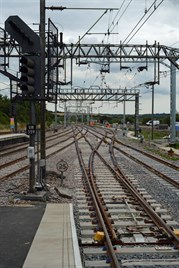
Read the peer reviews for this feature.
Download the graphs for this feature.
"We choose to install ETCS Level 3. Not because it is easy but because it is hard.” OK, so neither President Kennedy nor Network Rail Chief Executive Mark Carne actually said those words, but the challenge for NR in installing advanced signalling compares in some way with Kennedy’s moon challenge.
Kennedy justified his ambition by saying that going to the moon would “serve to organise and measure the best of our energies and skills”.
Similarly, ETCS Level 3 signalling is Carne’s answer to the capacity challenge the railway is facing. He argues that it’s the only way to create the capacity needed for NR’s increasingly crowded tracks. And the breathtaking extent of that challenge can’t be understated - Carne is talking about rolling out across the country a signalling system that doesn’t currently exist. That will surely measure the skills and energies of railway engineers and planners.
Level 3 has no lineside signals, a characteristic it shares with Level 2 (see panel). But it also has no train detection equipment fitted to the track, which is its defining difference. Removing train detection kit - whether track circuits or axle counters - cuts NR’s maintenance burden and boosts staff safety by reducing the number of staff it needs on or near the line. The improvement in capacity comes from Level 3 allowing moving block signalling, which should allow trains to run more closely together.
A more flexible railway
Lest this sound like a resignalling project, Carne counters that it’s just one element of his wider Digital Railway revolution (that also includes ticketing and timetabling) to create a more flexible railway that’s better suited to its customers, whether passenger or freight.
To add to the challenge, Carne wants all this done by 2029. To set that in context, compare its vaulting ambition with the Department for Transport’s 2007 plan that had Level 2 being installed by 2038, and 2012’s Rail Technical Strategy that suggested Level 3 installation should start in 2025 following a decade of development (see panel, page 12).
In contrast, NR is now talking about developing the idea of its Digital Railway in time to be included in the Initial Industry Plan for Control Period 6 (2019-2024). At the speed the railway’s planning wheels turn, that gives NR around two years.
To further increase the pressure, not so many years have passed since Britain’s railway last tried to introduce main line moving block signalling technology. Arguably, Railtrack’s demise was prompted in part by its 1999 admission that it couldn’t bring moving block signalling as planned to the West Coast Main Line, as part of a massive upgrade programme for Virgin’s 140mph tilting trains. The fatal accident on shattered track at Hatfield in 2000 played a bigger part, but both combined to depict Railtrack as a failing company.
In Railtrack’s place came Network Rail, with a mission to both restore the railway and the public’s confidence in it. Things have improved - passengers are now using trains in greater numbers than at almost any time in the last century and on a network vastly smaller than that the ‘Big Four’ inherited in the early 1920s. But NR has nonetheless been criticised for poor performance and delayed projects, even though passenger safety has greatly and consistently improved.
It’s the increasing numbers that have prompted Carne to unleash his Digital Railway revolution. Not every train has every seat occupied, but there is continuing pressure to run more trains at times passengers want them.
Nowhere is that more apparent than on the East and West Coast Main Lines, north from London. On both routes, open access operator Grand Central is pushing to be allowed to introduce new services or increase current provision, but it’s fighting against a view that the lines are already full with no space for more trains.
Meanwhile, on the Leeds-Manchester route, TransPennine Express is witnessing falling punctuality since the introduction of an extra hourly train path last May. The more crowded tracks become, the harder it is to run trains punctually.
Speaking to RailReview in November, Carne recounted a recent visit to the East Coast Main Line. He stood on a bridge over the line, and could hear birds singing for several minutes before any train passed. And yet, he said, he was told the line was full.
He likens his Digital Railway plan to the step change in air traffic control capability that came with computerisation. It increased capacity in a system that had been operating at its limits.
Carne has charged Jerry England with leading the revolution, and England is now assembling a team to take the ideas forward - both the European Train Control System signalling and the ticketing and information strand. The test bed for many of these ideas is pencilled in to be the Essex Thameside line - still better known as the London, Tilbury & Southend Railway, currently operated by National Express under the c2c brand.
Noting the precursor work from the Rail Technical Strategy (see panel), England tells RailReview: “Somewhat independently of that Mark has arrived, getting on for a year ago now, and as a newcomer and an outsider from a different industry he’s taken a look at the railway, and not surprisingly said that it looks pretty much like we haven’t really embraced new technology in the way other industries have.











